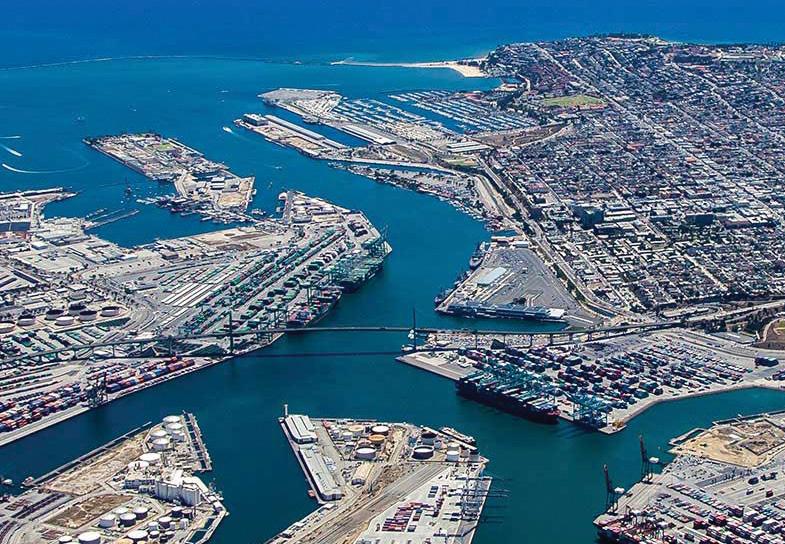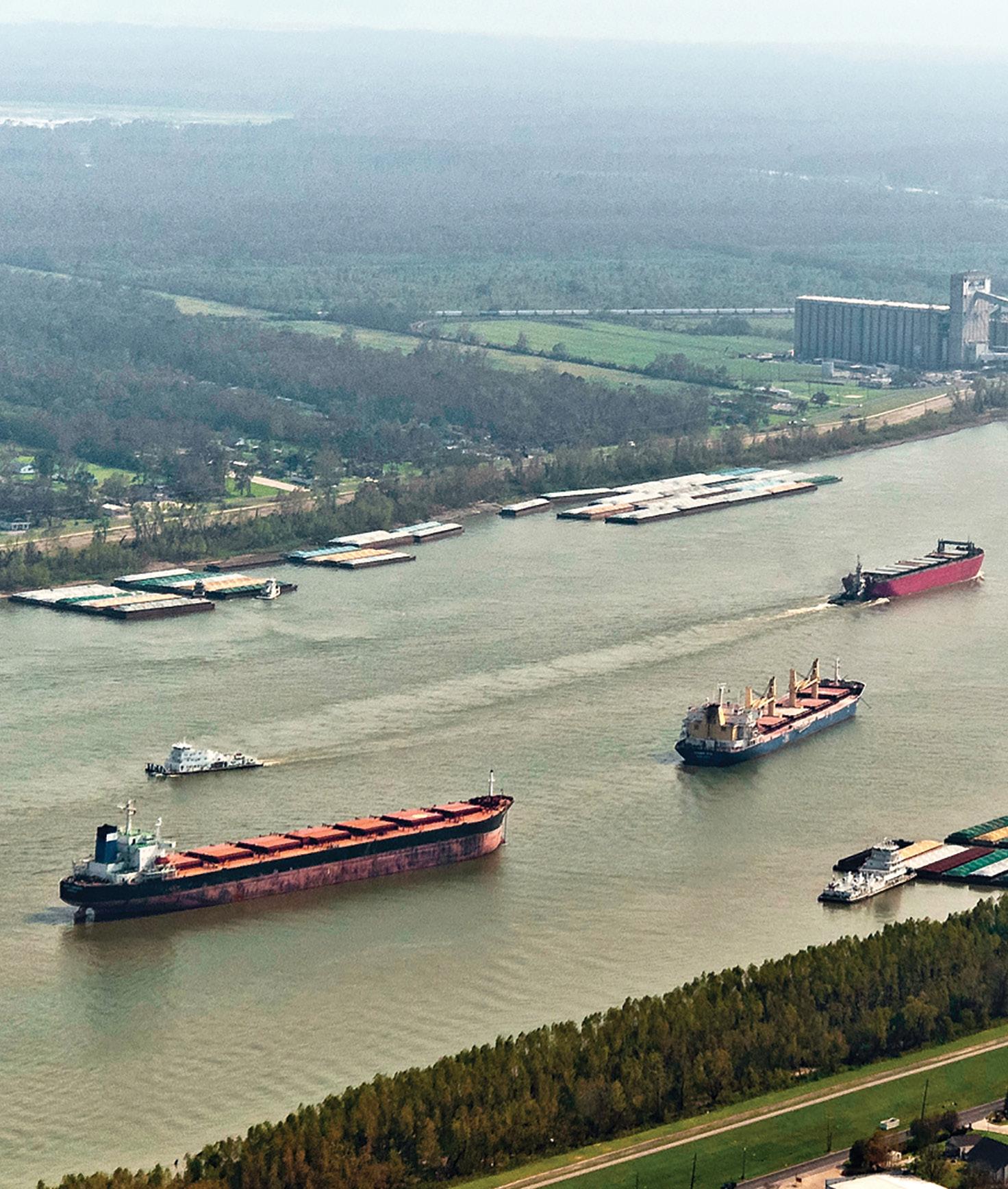
4 minute read
U.S. Maritime Administration
THE U.S. MARITIME ADMINISTRATION (MARAD) AND THE BIPARTISAN INFRASTRUCTURE LAW
The Bipartisan Infrastructure Law is a once-in-a-generation investment in our Nation’s multimodal infrastructure, which will grow the economy, enhance global economic competitiveness and make our transportation system more sustainable and equitable.
Advertisement
BIPARTISAN INFRASTRUCTURE LAW INVESTMENTS IN THE U.S. MARITIME INDUSTRY
In the maritime sector, the Bipartisan Infrastructure Law invests more than $17 billion in port infrastructure and waterways to: ■ Finance overdue maintenance and repairs. ■ Support the Nation’s supply chain by reducing congestion. ■ Reduce environmental impacts by cutting emissions near ports, boosting electrification and investing in other low-carbon technologies. Through MARAD, these investments will help build additional capacity at U.S. ports, improve cargo throughput and eliminate bottlenecks to reduce the time and cost of shipping goods. These projects will also augment national and regional economic vitality by supporting the creation of good-paying jobs.
BIPARTISAN INFRASTRUCTURE LAW INVESTMENT IN THE PORT INFRASTRUCTURE DEVELOPMENT PROGRAM
The Port Infrastructure Development Program (PIDP) is a discretionary grant program administered by MARAD, which awards funds on a competitive basis to projects that improve the safety, efficiency or reliability of the movement of goods into, out of, around or within a port. As part of the Department of Transportation (DOT), MARAD is responsible for awarding more than $2 billion ($450 million per year for FY22 – FY26) in funding appropriated by the Bipartisan Infrastructure Law to our Port Infrastructure Development Program. The PIDP supports efforts by ports and industry stakeholders to improve port and related freight infrastructure to meet the nation’s freight transportation needs. The program provides planning, capital funding, and project management assistance to improve ports’ capacity and efficiency. In concordance with environmental impact mitigation, PIDP grant applicants must explain how proposed projects will enhance environmental justice and advance the equity of environmental impacts on communities.
Funding Details
■The Bipartisan Infrastructure Law’s funding for the PIDP alone is roughly the same amount of money that has been invested in ports by all DOT grant programs since the
DOT began investing in ports with the 2009
Recovery Act. ■ Congress provided first-year funds of $293 million for the program in the FY2019
Consolidated Appropriations Act. Congress continued funding the program at $225 million in FY2020 and $230 million in FY2021. ■ On February 23, 2022, DOT Secretary
Buttigieg announced the notice of funding opportunity for the first round of funding for the PIDP provided by the Bipartisan
Infrastructure Law. ■ For FY2022, the Infrastructure and Jobs Act/
Bipartisan Infrastructure Law appropriated $450 million to the PIDP—almost double the
FY2021 investment. ■ Under the appropriations measure, an additional $234 million was provided for the program, bringing the total funding available for FY2022 to more than $680 million. ■ On October 28, 2022, MARAD awarded more than $703 million in grants to 41 projects in 22 states and one territory. In addition to funds provided in the Bipartisan
Infrastructure Law and Appropriations Act, the grants include unspent and unobligated funds from the FY2021 Appropriations Act.
Outcomes
The FY2022 grant awards made possible by the Bipartisan Infrastructure Law benefit coastal seaports, Great Lakes ports and inland river ports by helping improve supply chain reliability through increased port capacity and resilience, more efficient operations, reduced port emissions and new workforce opportunities. The PIDP, powered by funding from the Bipartisan Infrastructure Law, has awarded grants to several projects, large and small, supporting American ports. To view every awarded PIDP project since 2019, visit the PIDP webpage: www.maritime.dot.gov/PIDPgrants.
@DOTMARAD Maritime Administration
THE U.S. MARITIME ADMINISTRATION (MARAD) AND THE BIPARTISAN INFRASTRUCTURE LAW (continued)
BIPARTISAN INFRASTRUCTURE LAW INVESTMENT IN THE AMERICA’S MARINE HIGHWAY PROGRAM
The America’s Marine Highway Program (AMHP) supports the increased use of the nation’s navigable waterways to relieve landside congestion, provide new and efficient transportation options and increase the productivity of the surface transportation system. By working closely with public and private organizations, the AMHP helps develop and expand marine highway service options and facilitates further integration into the current U.S. surface transportation system.
All AMHP award recipients must apply, comply with, and implement all requirements of the Bipartisan Infrastructure Law “Buy America, Build America” provisions. Grant funds can be used to purchase low-emission U.S.-manufactured equipment that can alleviate supply chain bottlenecks.
There are currently 29 marine highway routes reaching 41 states, the district of columbia, and five u.S. Territories, and there are presently 58 designated marine highway projects.
Funding Details
■In December 2021, $12.6 million in grants was awarded to nine marine highway projects across the Nation. ■ On March 2, 2022, MARAD announced the availability of $25 million in new funding for the America’s Marine
Highways Program. à This funding was the largest single appropriation of funding in the program’s history—also made possible by the Bipartisan Infrastructure Law. ■ The FY2022 appropriations measure also expanded funding, providing another $14.8 million for the America’s Marine Highway program, bringing the total amount of funding available under this program to nearly $40 million. ■ MARAD awarded nearly $39 million in grants to 12 additional marine highway projects on October 6, 2022. ■ To view every awarded AMHP project since 2010, visit the AMHP Grants webpage: www.maritime.dot.gov/ grants-finances/marine-highways/grants.
Outcomes
The AMHP helps create and sustain American jobs in U.S. ports, on vessels and at shipyards. In addition, the AMHP meets the commitment of the Biden-Harris Administration’s Justice40 Initiative, with the goal that 40 percent of the overall benefits of certain Federal investments flow to disadvantaged communities that are marginalized, underserved, and overburdened by pollution. Preference is also given to AMHP projects that demonstrate a movement towards lower carbon emissions or near-zero emissions, reduce air emissions and vehicle miles traveled, and strengthen America’s supply chains.

ADDITIONAL INFO
Please visit our Bipartisan Infrastructure Law page for news, timelines, funding opportunities, and awards announcements. https://www.transportation.gov/bipartisan-infrastructure-law
@DOTMARAD Maritime Administration







